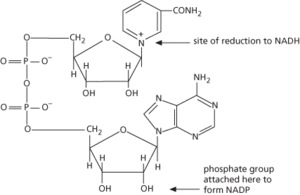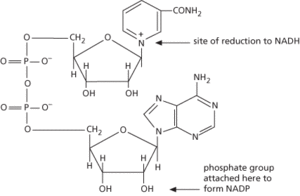A coenzyme, derived from the B vitamin nicotinic acid, that participates in many biological dehydrogenation reactions. NAD is characteristically loosely bound to the enzymes concerned. It normally carries a positive charge and can accept one hydrogen atom and two electrons to become the reduced form, NADH. NADH is generated during the oxidation of food; it then gives up its two electrons (and single proton) to the electron transport chain, thereby reverting to NAD+ and generating three molecules of ATP per molecule of NADH.
NADP (nicotinamide adenine dinucleotide phosphate) differs from NAD only in possessing an additional phosphate group. It functions in the same way as NAD although anabolic reactions (see anabolism) generally use NADPH (reduced NADP) as a hydrogen donor rather than NADH. Enzymes tend to be specific for either NAD or NADP as coenzyme.

NAD
A coenzyme, derived from the B vitamin nicotinic acid, that participates in many biological redox reactions (see formula). NAD is characteristically loosely bound to the enzymes concerned. It normally carries a positive charge (NAD+) and can accept one hydrogen atom and two electrons to become the reduced form, NADH. NADH is generated during the oxidation of food, especially by the reactions of the Krebs cycle. It then gives up its two electrons (and single proton) to the electron transport chain, thereby reverting to NAD+ and generating three molecules of ATP per molecule of NADH.
NADP (nicotinamide adenine dinucleotide phosphate) differs from NAD only in possessing an additional phosphate group. It functions in the same way as NAD although anabolic reactions (see anabolism) generally use NADPH (reduced NADP) as a hydrogen donor rather than NADH. Enzymes tend to be specific for either NAD or NADP as coenzyme.

NAD
- delete
- deletion((in genetics))
- deletion residual
- Deleuze, Gilles (1925–95)
- del factor
- D'Elhuyar, Don Fausto
- Delian (altar) problem
- Delian League
- deliberation
- delimiter
- deliquescence
- delisting
- delivery failure
- delivery pressure
- Dell
- Dellinger fade-out
- Dellingr
- Delmontian
- delocalization
- Delors Report
- Delphi
- Delphinus
- Del Rio, Andrès Manuel
- delta
- Delta Aquariid meteors